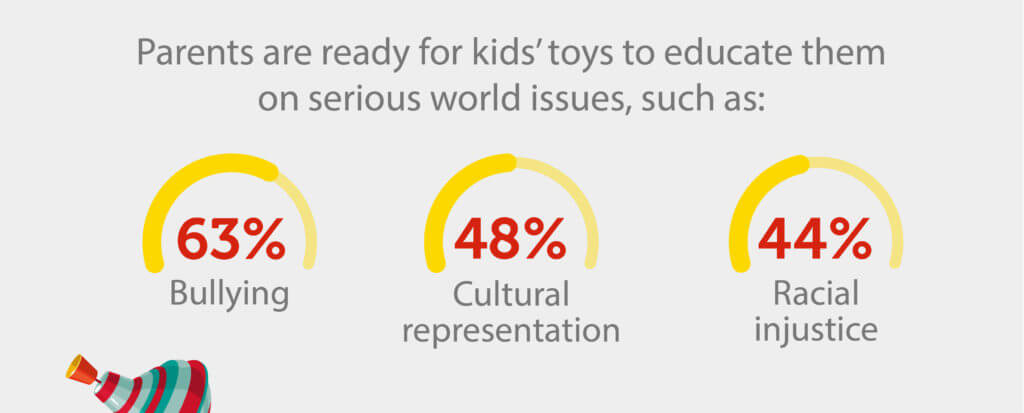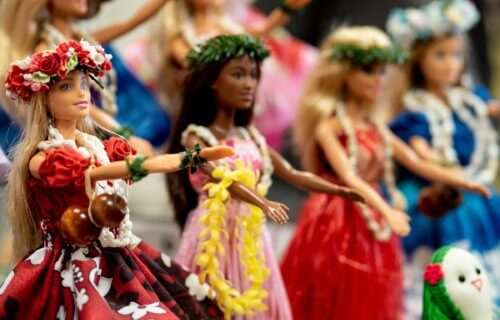NEW YORK — Half of parents believe that toys are some of the best teachers their kids will have (52%). A survey asking how 2,000 parents value their child’s toys’ ability to educate them finds that, on average, people think it’s important to start educating kids about issues in the world at seven years-old.
Let’s start with the basics first. Even in the age of tech, the average child has 26 toys. Yet more than a third (36%) of parents say their child continues to ask for new ones — at least once a week! Many parents may not mind, though, since 79 percent agree that play is a form of self-care for kids. Similarly, another 65 percent think toys these days actually help teach kids about the world.
Three in four parents of kids 14 and under used toys during the pandemic to help their child with social-emotional learning (77%), and most of these parents are still doing so (92%). Parents say their kids learn about being active (61%), social (58%), and responsible (47%) from their favorite toys.
Using toys to teach kids about racism, bullying
Conducted by OnePoll for The Toy Association, the survey found that parents are ready for kids’ toys to educate them on even more serious world issues, such as bullying (63%), cultural representation (48%), and racial injustice (44%).
This may be especially true for the two-thirds of parents who believe toys play a significant role in the development of kids’ beliefs and values (67%).
Most agree that the values of the toy industry have changed from when they were children (84%), and 88 percent believe toys are different today than when they were children.
“Toy companies are leading the way in providing children with access to tools that tackle critical social issues and create a more inclusive world,” says Adrienne Appell, executive vice president of marketing communications at The Toy Association, in a statement. “Now when you enter the toy aisle, you’ll be met with the most diverse assortment of dolls ever, as well as toys and games that help kids manage their emotions, promote kindness and acceptance, and celebrate different cultures.”

Nearly three-quarters of parents agree that toys these days are more progressive and diverse than they were when they were kids (73%) and the same percentage of those respondents appreciate the efforts made to be more representative.
Half of parents shared that they wish that they had a toy that felt closer to who they were as kids (52%), which may be why 58 percent opt to look for toys that best suit their kids now.
One in six parents rated inclusivity and representation in their own toys as “poor” or “fair,” compared to 55 percent of parents who would say the opposite of their kid’s toys – especially parents of kids 14 and under (72%).
Those parents also expressed interest in purchasing toys that expose their child to diversity and teach inclusion (68%).
Grandparents are shopping for diverse toys too
Similarly, 38 percent of grandparents surveyed say that when shopping for their grandchild, they look out for toys that represent diverse backgrounds, cultures, or lifestyles, and more than a quarter also look for toys that teach kids about environmental issues (28%).
“For generations, toys have taught children about the world around them, and today’s toys are more well-rounded and educational,” adds Appell. “With so many toys and games on the market that raise awareness about social issues and other causes, like environmentalism, there are countless opportunities to start a dialogue with kids on how to create a more caring and inclusive world.”
“As an added bonus, many of these toys are fun for adults too, making it easy for kids and parents to play, learn, and build memories together – in fact, when purchasing toys, most parents consider options they’ll enjoy playing with their child (78%).”


I have said it before and I will say it again: ” Children are always learning. Every waking hour of the day they are learning. The only question is what are they learning. Frequently it is not the lesson the parents think they are teaching.”
they
Children learn in multiple ways. They touch the stove with their mother yelling STOP to learn about hot things. They watch and listen as daddy lies about something insignificant and learn that sometimes lies get you what you want. This list includes toys. If they are a child male and get a doll house as a present they learn a more genteel way of life compared to receiving a toy fort and the list goes on and on.
If the parents will pay attention to and listen to their children, they will discover
what the children are learning and make corrections. Unfortunately, many parents spend a large amount of time directing and correcting instead of listening so they miss many golden teaching moments.
I am not a ghild psychologist, I am only relating what I have learned in my 80 years of working with many children